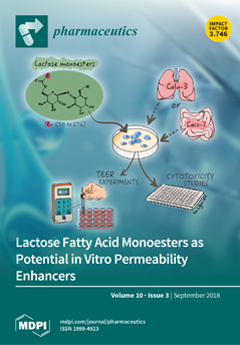In the present study, the screening of Mirabegron (MBR) co-amorphous was performed to produce water-soluble and thermodynamically stable MBR co-amorphous with the purpose of overcoming the water solubility problem of MBR. MBR is Biopharmaceutics Classification System (BCS) class II drug used for the
[...] Read more.
In the present study, the screening of Mirabegron (MBR) co-amorphous was performed to produce water-soluble and thermodynamically stable MBR co-amorphous with the purpose of overcoming the water solubility problem of MBR. MBR is Biopharmaceutics Classification System (BCS) class II drug used for the treatment of an overreactive bladder. The co-amorphous screening was carried out by means of the vacuum evaporation crystallization technique in methanol solvent using three water-soluble carboxylic acids, characterized by a pKa difference greater than 3 with MBR such as fumaric acid (FA),
l-pyroglutamic acid (PG), and citric acid (CA). Powder X-ray diffraction (PXRD) results suggested that all solid materials produced at MBR-FA (1 equivalent (eq.)/1 equivalent (eq.)), MBR-PG (1 eq./1 eq.), and MBR-CA (1 eq./1 eq.) conditions were amorphous state solid materials. Furthermore, by means of solution-state nuclear magnetic resonance (NMR) (
1H,
13C, and 2D) and attenuated total reflection Fourier transform infrared (ATR-FTIR) spectroscopy, we could assess that MBR and carboxylic acid molecules were linked via ionic interactions to produce MBR co-amorphous. Besides, solid-state cross polarization (CP)/magic angle spinning (MAS)
13C-NMR analysis was conducted for additional assessment of MBR co-amorphous. Afterwards, dissolution tests of MBR co-amorphouses, MBR crystalline solid, and MBR amorphous were carried out for 12 h to evaluate and to compare their solubilities, dissolution rates, and phase transformation phenomenon. Here, the results suggested that MBR co-amorphouses displayed more than 57-fold higher aqueous solubility compared to MBR crystalline solid, and PXRD monitoring result suggested that MBR co-amorphouses were able to maintain their amorphous state for more than 12 h. The same results revealed that MBR amorphous exhibited increased solubility of approximatively 6.7-fold higher compared to MBR crystalline solid. However, the PXRD monitoring result suggested that MBR amorphous undergo rapid phase transformation to crystalline form in just 35 min and that within an hour all MBR amorphous are completely converted to crystalline solid. Accordingly, the increase in MBR co-amorphous’ solubility was attributed to the presence of ionic interactions in MBR co-amorphous molecules. Moreover, from the differential scanning calorimetry (DSC) monitoring results, we predicted that the high glass transition temperature (
Tg) of MBR co-amorphous compared to MBR amorphous was the main factor influencing the phase stability of MBR co-amorphous.
Full article






